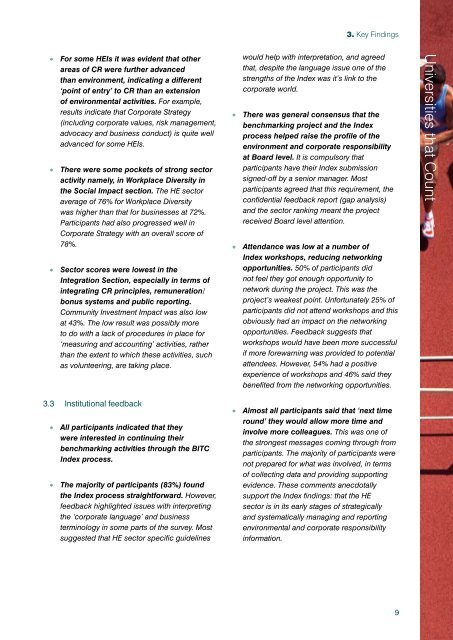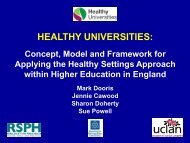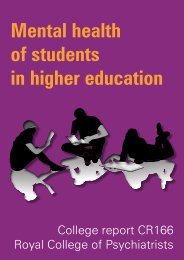Universities
Universities that Count - EAUC
Universities that Count - EAUC
- No tags were found...
You also want an ePaper? Increase the reach of your titles
YUMPU automatically turns print PDFs into web optimized ePapers that Google loves.
3. Key Findings• For some HEIs it was evident that otherareas of CR were further advancedthan environment, indicating a different‘point of entry’ to CR than an extensionof environmental activities. For example,results indicate that Corporate Strategy(including corporate values, risk management,advocacy and business conduct) is quite welladvanced for some HEIs.• There were some pockets of strong sectoractivity namely, in Workplace Diversity inthe Social Impact section. The HE sectoraverage of 76% for Workplace Diversitywas higher than that for businesses at 72%.Participants had also progressed well inCorporate Strategy with an overall score of78%.• Sector scores were lowest in theIntegration Section, especially in terms ofintegrating CR principles, remuneration/bonus systems and public reporting.Community Investment Impact was also lowat 43%. The low result was possibly moreto do with a lack of procedures in place for‘measuring and accounting’ activities, ratherthan the extent to which these activities, suchas volunteering, are taking place.would help with interpretation, and agreedthat, despite the language issue one of thestrengths of the Index was it’s link to thecorporate world.• There was general consensus that thebenchmarking project and the Indexprocess helped raise the profile of theenvironment and corporate responsibilityat Board level. It is compulsory thatparticipants have their Index submissionsigned-off by a senior manager. Mostparticipants agreed that this requirement, theconfidential feedback report (gap analysis)and the sector ranking meant the projectreceived Board level attention.• Attendance was low at a number ofIndex workshops, reducing networkingopportunities. 50% of participants didnot feel they got enough opportunity tonetwork during the project. This was theproject’s weakest point. Unfortunately 25% ofparticipants did not attend workshops and thisobviously had an impact on the networkingopportunities. Feedback suggests thatworkshops would have been more successfulif more forewarning was provided to potentialattendees. However, 54% had a positiveexperience of workshops and 46% said theybenefited from the networking opportunities.<strong>Universities</strong> that Count3.3 Institutional feedback• All participants indicated that theywere interested in continuing theirbenchmarking activities through the BITCIndex process.• The majority of participants (83%) foundthe Index process straightforward. However,feedback highlighted issues with interpretingthe ‘corporate language’ and businessterminology in some parts of the survey. Mostsuggested that HE sector specific guidelines• Almost all participants said that ‘next timeround’ they would allow more time andinvolve more colleagues. This was one ofthe strongest messages coming through fromparticipants. The majority of participants werenot prepared for what was involved, in termsof collecting data and providing supportingevidence. These comments anecdotallysupport the Index findings: that the HEsector is in its early stages of strategicallyand systematically managing and reportingenvironmental and corporate responsibilityinformation.





